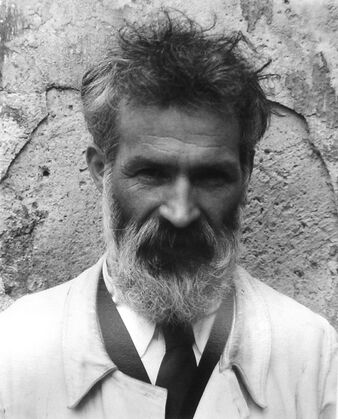Difference between revisions of "Constantin Brâncuşi"
Jump to navigation
Jump to search
Sorindanut (talk | contribs) |
m (Text replacement - "imagesize = 342px" to "imagesize = 338px") |
||
| (5 intermediate revisions by the same user not shown) | |||
| Line 1: | Line 1: | ||
{{Infobox artist | {{Infobox artist | ||
|image = Edward_Steichen_-_Brancusi.jpg | |image = Edward_Steichen_-_Brancusi.jpg | ||
| − | |imagesize = | + | |imagesize = 338px |
| − | |caption = | + | |caption = Brâncuși in 1922. Photo: Edward Steichen. |
|birth_date = {{birth date|1876|2|19|mf=y}} | |birth_date = {{birth date|1876|2|19|mf=y}} | ||
|birth_place = Hobiţa, Gorj | |birth_place = Hobiţa, Gorj | ||
| − | | | + | |death_date = {{Death date and age|1957|3|16|1876|2|19|mf=y}} |
| + | |death_place = Paris, France | ||
}} | }} | ||
| − | '''Constantin Brâncuşi''' was a Romanian-born sculptor who made his career in France. | + | '''Constantin Brâncuşi''' was a Romanian-born sculptor who made his career in France. His most well-known works include the ''Sleeping Muse'' (1908), ''The Kiss'' (1908), ''Prometheus'' (1911), ''Mademoiselle Pogany'' (1913), ''The Newborn'' (1915), ''Bird in Space'' (1919) and ''The Column of the Infinite (Coloana infinitului)'', also known as ''The Endless Column'' (1938). He left behind around 215 sculptures and 1200 photographs. |
| − | |||
| − | |||
| − | |||
| − | He | ||
==Links== | ==Links== | ||
| − | *[http://en.wikipedia.org/wiki/Brancusi | + | * [http://www.guggenheim.org/new-york/collections/collection-online/artists/698 Guggenheim Museum] |
| − | *[http://ro.wikipedia.org/wiki/Constantin_Br%C3%A2ncu%C8%99i | + | * [https://www.moma.org/interactives/objectphoto/artists/738.html Biography and chronology on MoMA's Object:Photo resource] |
| − | + | * [http://en.wikipedia.org/wiki/Brancusi Wikipedia] | |
| + | * [http://ro.wikipedia.org/wiki/Constantin_Br%C3%A2ncu%C8%99i Wikipedia-RO] | ||
Latest revision as of 00:00, 26 May 2022
 Brâncuși in 1922. Photo: Edward Steichen. | |
| Born |
February 19, 1876 Hobiţa, Gorj |
|---|---|
| Died |
March 16, 1957 (aged 81) Paris, France |
Constantin Brâncuşi was a Romanian-born sculptor who made his career in France. His most well-known works include the Sleeping Muse (1908), The Kiss (1908), Prometheus (1911), Mademoiselle Pogany (1913), The Newborn (1915), Bird in Space (1919) and The Column of the Infinite (Coloana infinitului), also known as The Endless Column (1938). He left behind around 215 sculptures and 1200 photographs.